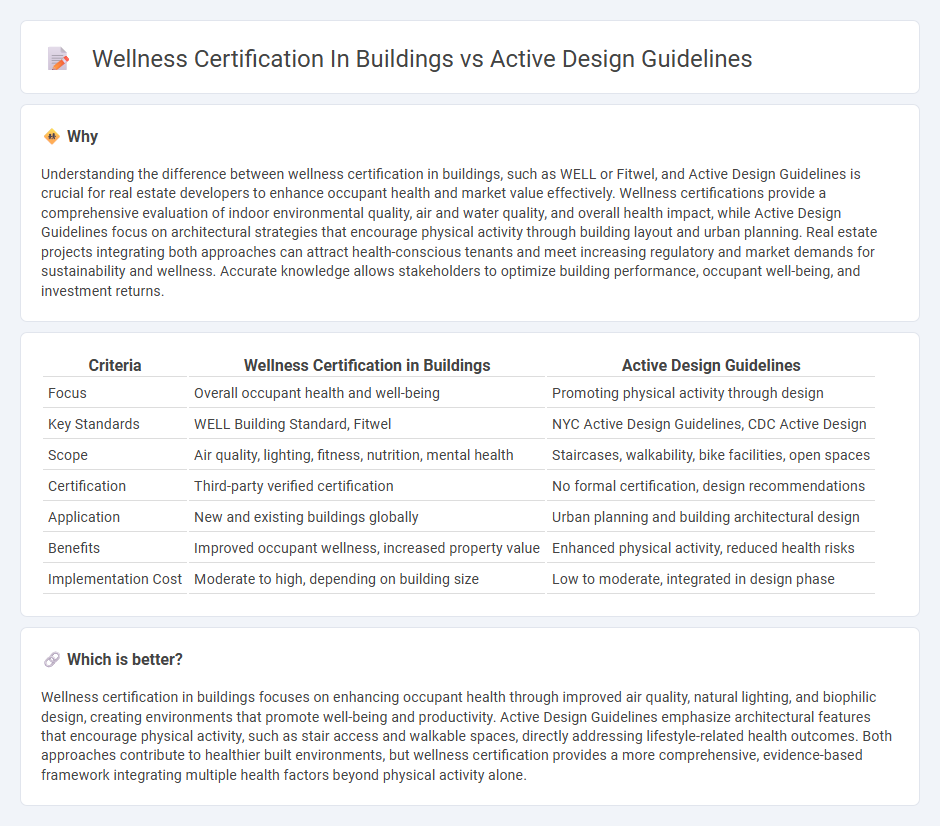
Wellness certification in buildings focuses on enhancing occupant health through measures like air quality, natural lighting, and biophilic design, aligning with global WELL Building Standards. Active Design Guidelines prioritize architectural elements that promote physical activity and movement, such as accessible staircases, walkable layouts, and ergonomic workspaces to combat sedentary lifestyles. Explore how integrating these approaches can transform real estate developments into healthier, more vibrant environments.
Why it is important
Understanding the difference between wellness certification in buildings, such as WELL or Fitwel, and Active Design Guidelines is crucial for real estate developers to enhance occupant health and market value effectively. Wellness certifications provide a comprehensive evaluation of indoor environmental quality, air and water quality, and overall health impact, while Active Design Guidelines focus on architectural strategies that encourage physical activity through building layout and urban planning. Real estate projects integrating both approaches can attract health-conscious tenants and meet increasing regulatory and market demands for sustainability and wellness. Accurate knowledge allows stakeholders to optimize building performance, occupant well-being, and investment returns.
Comparison Table
| Criteria | Wellness Certification in Buildings | Active Design Guidelines |
|---|---|---|
| Focus | Overall occupant health and well-being | Promoting physical activity through design |
| Key Standards | WELL Building Standard, Fitwel | NYC Active Design Guidelines, CDC Active Design |
| Scope | Air quality, lighting, fitness, nutrition, mental health | Staircases, walkability, bike facilities, open spaces |
| Certification | Third-party verified certification | No formal certification, design recommendations |
| Application | New and existing buildings globally | Urban planning and building architectural design |
| Benefits | Improved occupant wellness, increased property value | Enhanced physical activity, reduced health risks |
| Implementation Cost | Moderate to high, depending on building size | Low to moderate, integrated in design phase |
Which is better?
Wellness certification in buildings focuses on enhancing occupant health through improved air quality, natural lighting, and biophilic design, creating environments that promote well-being and productivity. Active Design Guidelines emphasize architectural features that encourage physical activity, such as stair access and walkable spaces, directly addressing lifestyle-related health outcomes. Both approaches contribute to healthier built environments, but wellness certification provides a more comprehensive, evidence-based framework integrating multiple health factors beyond physical activity alone.
Connection
Wellness certification in buildings promotes health-focused features such as improved air quality, natural lighting, and ergonomic design, which directly align with Active Design Guidelines emphasizing physical activity and occupant well-being. Incorporating these standards enhances real estate value by attracting health-conscious tenants and reducing long-term operational costs through sustainable practices. Real estate developments integrating both wellness certification and Active Design Guidelines demonstrate commitment to holistic occupant wellness and community vitality.
Key Terms
Building Design Standards
Active Design Guidelines prioritize architectural strategies that promote physical activity through integrated stairwells, walkable environments, and accessible fitness amenities, enhancing occupant health and productivity. Wellness certifications, such as WELL and Fitwel, encompass a broader spectrum by evaluating air quality, lighting, thermal comfort, and mental well-being alongside physical activity features within Building Design Standards. Explore comprehensive comparisons to understand how these frameworks shape healthier built environments.
Occupant Health
Active Design Guidelines prioritize creating built environments that promote physical activity, such as incorporating stairs, walkable paths, and ergonomic workspaces to enhance occupant health. Wellness certification programs, like WELL or Fitwel, offer comprehensive standards that integrate active design with air quality, lighting, and mental well-being factors to holistically support occupant health. Explore the differences and benefits of each to optimize building health standards.
Certification Criteria
Active Design Guidelines promote building features that encourage physical activity, such as accessible staircases, walkable pathways, and ergonomic workspaces. Wellness certification programs like WELL and Fitwel assess comprehensive health metrics, including air quality, lighting, and occupant comfort, alongside physical activity components. Explore the nuanced certification criteria to understand how each approach enhances building health and occupant wellness.
Source and External Links
Active Design Guidelines | City of New York - NYC.gov - The Active Design Guidelines are a comprehensive manual developed by NYC to help designers create buildings and neighborhoods that promote physical activity and combat obesity, integrating strategies early in projects to enhance health and active living.
Promising Practices :: Active Design Guidelines - These guidelines offer architects and urban designers evidence-based strategies for designing healthier buildings and public spaces that encourage physical activity, drawing on historical successes in disease prevention through better urban design.
Active Design Guidelines - Community Commons - This manual presents best practices and research-based strategies for architects and urban planners to create active, healthy environments through thoughtful design of neighborhoods, streets, and outdoor spaces.
 dowidth.com
dowidth.com